Mosaic Conservation
At the Royal Garrison Church of St George
Kalypso Kampani
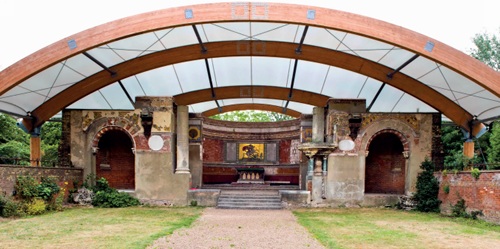 |
||
| Completed in 2015, a new tensile fabric and glulam canopy spans the surviving structure at the east end of the site, helping to ensure its future. (Photo: Chris Mansfield) |
The 19th-century mosaics by Antonio Salviati at the Royal Garrison Church in Woolwich, London had been deteriorating for many years. A major conservation project was undertaken in 2015 to save them.
THE CHURCH
The Royal Garrison Church, also known as St George’s Chapel, is located on the Grand Depot Road in Woolwich within the Royal Artillery Barracks site.
The church, dedicated to St George, was built in 1863-67 in an early Christian/Italian Neo-Romanesque style and was designed by the architect Thomas Henry Wyatt. The elaborate internal decorations included 1870s mosaics of Venetian glass (designed by JR Clayton of Clayton and Bell and executed by Antonio Salviati, Burke and Co), stained glass windows in the nave (also by JR Clayton) and a variety of decorative stone dressings.
The Italianate church became a royal garrison church in 1928, but in June 1944 it was hit by a V1 flying bomb which destroyed its roofs, walls and windows. Much of the remaining structure had to be demolished, leaving just the roofless transept and chancel, with its semicircular apse, at the east end of the site, and the entrance porch at the west end. After the war a walled public garden was created within the ruins of the nave. The apse retains marble memorials to members of the Royal Artillery who were awarded the Victoria Cross and exceptional mosaics of Venetian smalti (glass mosaic tiles). The latter include an excellent representation of St George and the Dragon, which forms part of the Victoria Cross Memorial.
Today, the church remains consecrated and is still used for open-air services by personnel from the nearby Royal Artillery Barracks. However, exposure to the elements, particularly rain and frost, has resulted in the gradual deterioration of the building and the memorial mosaics, which required urgent conservation and restoration treatments.
The Royal Garrison Church was listed at Grade II in 1970 and was later placed on Historic England’s Heritage at Risk Register due to its poor condition. Heritage of London Trust Operations (HOLTOP – a building preservation trust) became involved in 2008, and took ownership from Defence Estates three years later.
The trust developed a scheme to safeguard the surviving mosaics and increase public access with the advice of a diverse professional team. The team included APEC Architects Limited, who designed a new canopy roof (later provided by Fabric Architecture) to span the surviving structure at the east end of the site, helping to ensure its future. A package of conservation works was scoped out by Thomas Ford & Partners and Historic England, based on the results of a condition survey. The works included removal of the most fragile mosaics from the walls and their storage for future conservation.
With much of the surviving mosaic decoration already removed in panels, in November 2014 Skillington Workshop Limited was commissioned to undertake the mosaics conservation project, which was completed under the author’s guidance and supervision. The mosaic conservation project involved the conservation and reinstatement of the removed panels, and the in situ repair of the mosaics in the apse and on the transept columns.
Works started in December 2014 and were completed in July 2015 as part of a project funded by an HLF grant and matching funding from a variety of sources, including Historic England.
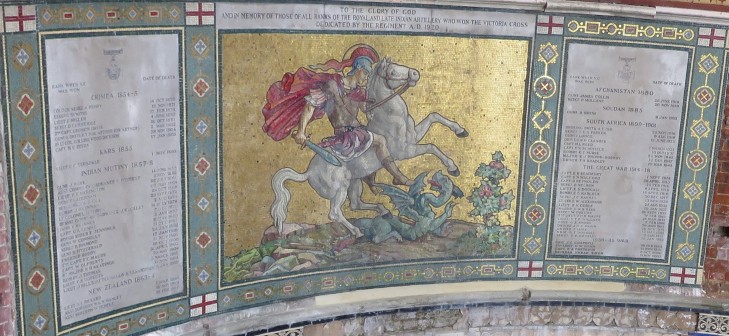 |
|
| The restored St George and the Dragon mosaic, which forms part of the church’s Royal Artillery Victoria Cross Memorial |
ANTONIO SALVIATI’S MOSAICS
The mosaics were created by the Italian glass manufacturer Antonio Salviati (1816-1890) who revived the smalti mosaic technique of the Middle Ages. Salviati had become interested in the crumbling mosaics of St Mark’s Basilica in Venice. Aiming to save these Byzantine treasures, he joined forces with master glassmaker Lorenzo Radi from Murano near Venice and in 1859 they founded a glass-making and mosaic company based in Murano. In 1898 they opened the company’s new London premises at 235 Regent Street.
Salviati installed decorative mosaics in a number of British churches and cathedrals. Examples of his work include the mosaics which decorate the Albert Memorial in Kensington Gardens, London and many of the interior mosaics of St Paul’s Cathedral, the Houses of Parliament and the Victoria & Albert Museum.
CONDITION ASSESSMENT
The condition survey conducted in October 2014 determined the instability of the in situ wall mosaics and the level of deterioration of the removed mosaics. The absence of roof cover and exposure of the mosaics to decades of rain, hail, snow and direct sunlight had weakened the mortar which bound the mosaics, resulting in detachment of tesserae, voids in the mortar, and loss of original material. Active microbiological growth was also damaging the mosaics.
The conservation of the wall mosaics was prioritised to prevent further degradation and losses.
CONSERVATION TREATMENT OF THE MOSAICS
The project involved in situ conservation of the wall mosaics in the apse, offsite conservation at Skillington’s workshop of the removed mosaics and, finally, the reinstallation of the latter in their original locations.
A detailed survey was undertaken prior to the treatments to document the damage and losses. Documentation was carried out throughout the conservation treatments using detailed photographs, videos and illustrations. All damage and losses of original mortar and tesserae were also recorded.
IN SITU CONSERVATION AND RESTORATION
The following wall mosaics were restored:
- the central representation of St George and the Dragon, which stands out due to its artistic quality
- two memorial panels of ornamental mosaic motifs, which are located on either side of St George and list Victoria Cross recipients from the Royal and Late Indian Artillery
- four smaller high-quality mosaics depicting a peacock and a phoenix on the columns of the transept.
THE TREATMENT
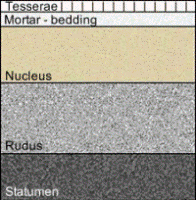 |
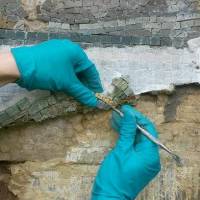 |
|
| Cross-section diagram showing the constituent layers of the Salviati mosaics | Removing traces of the old cement-based mortar using dental tools |
Conservation treatments on the wall mosaics began with the application of biocide, followed by the removal of algae and clinging plants using dental tools and brushes. The next step was the consolidation and resetting of loose tesserae on the nucleus layer (see diagram, below left); the grouting of voids, delaminations and cracks; and the strengthening of the underlying mortars to avoid further loss of original material and to reinforce the structure. After English Heritage approval, a suitable cement-based mortar was selected for grouting and the installation procedures (Mapei Kerabond T mixed with Isolastic, a latex additive which improves elasticity).
The next step was to carefully remove the old cement-based repairs from the lower area of the St George mosaic after facing the surrounding tesserae with thick cotton gauze for their protection. The delaminated mosaic sections, supported by the facing fabric, were gently separated and lifted from the nucleus layer using chisels and a hammer. The old bedding layer was then completely removed using dental tools in order to proceed with the application of the new mortar.
The new mortar was applied on the nucleus layer and the mosaic was reinstalled in its original location. After pre-wetting all areas using de-ionised water and isopropyl alcohol (2-propanol) in a 1/1 mix-ratio, the mosaic was levelled off using a flat wooden block and a hammer. The excess mortar was removed and the area was cleaned using warm de-ionised water.
MOSAIC REPRODUCTIONS
To restore aesthetic unity, the decision was taken to reproduce missing elements of the St George mosaic and so create an impression of the scheme’s former glory. The original mosaic and its losses were mapped onto tracing paper and new smalti tesserae were ordered to match the tones and texture of the originals. Once made, the new pieces were assembled to fit the gaps using the ‘indirect’ mosaic technique. This involves using a temporary surface-fabric to reproduce the mosaic losses, with pieces of the mosaic temporarily face-fixed onto it using a water soluble adhesive, accurately following the tracings of the original mosaic. When completed, sections of assembled mosaics were offered up to the original wall mosaic, pressing the new tesserae sections into the fresh mortar, and the fabric was then removed by steam cleaning.
WORKSHOP CONSERVATION
Structural repairs to the detached mosaic sections were done in the workshop. As some of the most fragile sections had fragmented, and the mortar remaining on the back varied in thickness from 3-6 cm, blobs of clay were applied to the back of the fragments to join them up at the appropriate height, providing a level surface for the facing procedure. The facing-fabrics that had been used previously during the removal of the mosaics from the wall were then removed using hot water and tweezers, and the surfaces were carefully cleaned before re-facing. Once securely bound with high quality cotton gauze, the unified sections could be safely turned over so the back could be worked on. Any clay which still adhered was easily removed once it had dried out.
To prepare the mosaic pieces for reinstallation it was imperative to remove all traces of the old cement-based mortars. This was principally done using power tools while smaller traces were removed using dental tools.
Again, the mosaic designs had been carefully mapped onto tracing paper prior to removal, so the tracing maps were used to accurately guide the reinstallation.
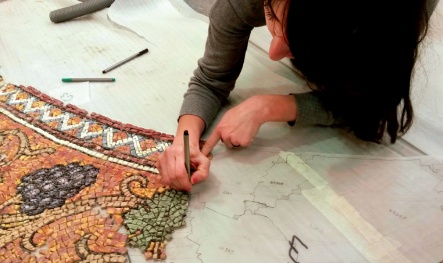 |
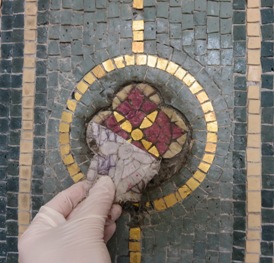 |
||
| Above left: An area of restored mosaic is mapped onto tracing paper. Above right: A reproduced section is fixed into position to replace damaged tesserae |
|||
REINSTALLATION
Remaining original mortar was removed from the walls and arches, and the corroded metallic fixing hooks were replaced by aluminium screws fixed into the new render. The tracing maps were transferred onto the walls using a technique called pouncing in which powdered pigment (or ‘pounce’) is dusted over perforations in the tracing sheet to transfer the outline onto the wall behind it. The mosaics were then installed in their original locations, working upwards from the lower areas and using a cement-based mortar for exterior use.
Selecting appropriate mortars for both the consolidation and the installation of the mosaics was crucial. When choosing a mortar, the following factors should be considered: compatibility with the original mortars, properties, performance, deformability and resistance to the environmental conditions (in this case, an exterior environment). The original mortars used in the mosaics were cement-based – the use of Portland cement in the manufacture of Victorian mosaics was very common.
Finally, after testing different cleaning methods and chemicals, a solution of 8-10 per cent ammonium carbonate in de-ionised water was used followed by steam cleaning to remove any dirt and remaining mortar deposits.
The first phase of the Salviati mosaics conservation project in Woolwich was successfully completed in July 2015 after seven months of remedial conservation treatments. The canopy was installed in June 2015 and will play an important role by protecting the mosaics from direct exposure to the elements. A second package of conservation works is being developed by HOLTOP in conjunction with Historic England and architects Thomas Ford & Partners. The site is now open to the public every Sunday.
~~~
Further Information
English Heritage, Practical Building Conservation: Mortars, Renders & Plasters, Ashgate, Farnham, 2011
J Fawcett (ed), Historic Floors: Their History and Conservation, Butterworth-Heinemann, Oxford, 1998
A Wright, Technical Pamphlet 15: Care and Repair of Old Floors, SPAB, London, 1999



